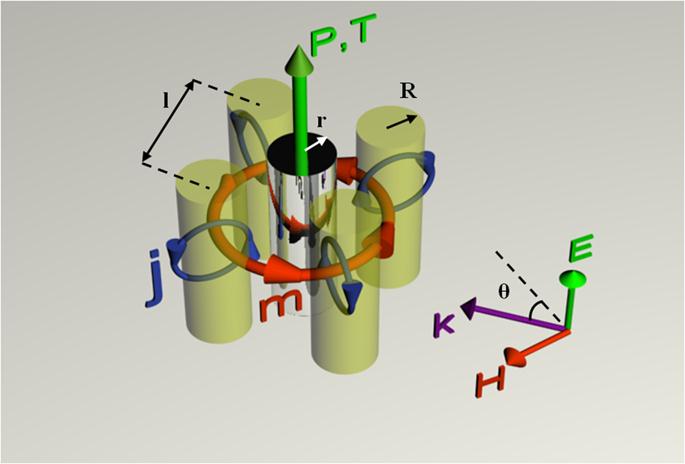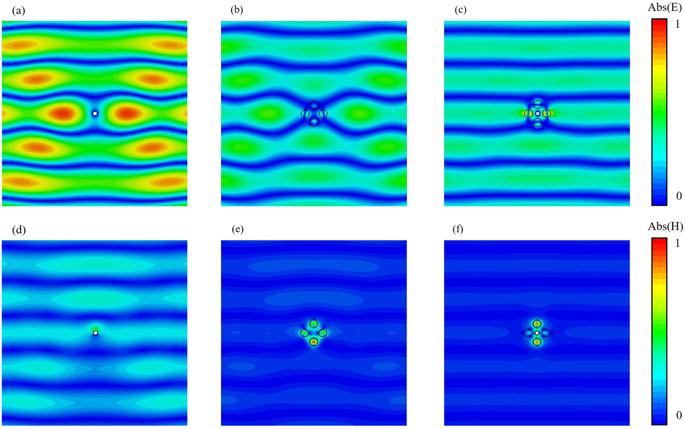Invisible needles: scientists have developed a method of masking nanosensors for optics and biomedicine
An international scientific group consisting of scientists from the National Research University "MISiS" and the Polytechnic University of Turin developed a model of a new metamaterial that will improve the accuracy of nanosensors in optics and biomedicine by masking them from external radiation. An article about the results of the study was published in the journal Scientific Reports .
The development of a new metamaterial model that masks nanosensors is being carried out within the framework of the Russian-Italian project ANASTASIA (Advanced Non-radiating Architectural Scattering Tenuously And Sustaining Invisible Anapoles), which aims to simulate and then recreate such a metamaterial that would allow objects to be made invisible at the nanoscale level. in all wave ranges.
The main element of a metamaterial modeled by scientists is a metamolecule consisting of four dielectric cylinders of lithium tantalate - LiTaO3 - with a radius of 5 microns. Forming a kind of shell for a nanosensor, dielectrics interact with radiation, and a so-called state of anapole, a non-emitting scatterer, arises. (Fig. 1). As a result, the object becomes invisible to an external observer (Fig. 2 c). Individually, all elements — the nanosensor and dielectrics — scatter the radiation and strongly distort the picture of the electric and magnetic fields (Fig. 2 a, b).

Figure 1 is a visualization of a metamolecule consisting of a nanosensor — a metal conductor cylinder (center) and four dielectric cylinders (at the edges), where P is the conductor electric dipole moment, T is the toroid moment of the dielectric shell.

Figure 2 - visualization of the visible radiation of elements outside the metamolecule and in the form of a metamolecule, where (a) is the central element without a shell; (b) - shell elements without a central element; (c) - the central element in the shell.
For calculations, a metallic conductor with a radius of 2.5 μm was used, simulating a nanosensor and having a very high wave scattering, which made it possible to carry out calculations for the highest possible level of radiation. The simulation took place in the terahertz range, between the infrared and microwave ranges.
Scientists used LiTaO3, lithium tantalate, as the material of the metamolecule, although other materials can be used depending on the application. In nano-optics, for example, it will be possible to work with silicon and germanium.
According to the ANASTASIA project manager from the NITU "MISIS", associate professor Alexey Basharin, the created metamaterial has prospects for use in biomedicine, for example, due to the use of potassium chloride as a shell.
The next stage of the study - the experimental creation of the proposed structure in the laboratory - is scheduled for autumn 2018.
At the moment, experience has been gained in creating materials and objects that are transparent for a very narrow range of radiation and hide objects only at a certain angle. The task that the participants of the ANASTASIA project set for themselves is to summarize the experience of creating such structures and develop a theory with which it will be possible to model and then create metamaterials that hide objects from any angle and in a wide range.
The development of a new metamaterial model that masks nanosensors is being carried out within the framework of the Russian-Italian project ANASTASIA (Advanced Non-radiating Architectural Scattering Tenuously And Sustaining Invisible Anapoles), which aims to simulate and then recreate such a metamaterial that would allow objects to be made invisible at the nanoscale level. in all wave ranges.
“To hide a large object is actually simpler than a small one,” says the post-graduate student of the Superconducting Metamaterials Laboratory at NUST MISiS and the main author of the article, Anar Ospanova. - There are various camouflage techniques and stealth technologies. But when we deal with nanoscale objects — for example, with needle-sensors in biomedicine or physics, the situation becomes more complicated. Usually, nanosensors are commensurate with the objects under study, therefore, when entering the medium, they are greatly influenced by it - they change the pressure in it, scatter radiation, and it becomes difficult to understand where the characteristics of the needle are, and where it is the object itself. We decided to “hide” the radiation from nanosensors and thus increase the accuracy of their work. ”
The main element of a metamaterial modeled by scientists is a metamolecule consisting of four dielectric cylinders of lithium tantalate - LiTaO3 - with a radius of 5 microns. Forming a kind of shell for a nanosensor, dielectrics interact with radiation, and a so-called state of anapole, a non-emitting scatterer, arises. (Fig. 1). As a result, the object becomes invisible to an external observer (Fig. 2 c). Individually, all elements — the nanosensor and dielectrics — scatter the radiation and strongly distort the picture of the electric and magnetic fields (Fig. 2 a, b).

Figure 1 is a visualization of a metamolecule consisting of a nanosensor — a metal conductor cylinder (center) and four dielectric cylinders (at the edges), where P is the conductor electric dipole moment, T is the toroid moment of the dielectric shell.

Figure 2 - visualization of the visible radiation of elements outside the metamolecule and in the form of a metamolecule, where (a) is the central element without a shell; (b) - shell elements without a central element; (c) - the central element in the shell.
For calculations, a metallic conductor with a radius of 2.5 μm was used, simulating a nanosensor and having a very high wave scattering, which made it possible to carry out calculations for the highest possible level of radiation. The simulation took place in the terahertz range, between the infrared and microwave ranges.
Scientists used LiTaO3, lithium tantalate, as the material of the metamolecule, although other materials can be used depending on the application. In nano-optics, for example, it will be possible to work with silicon and germanium.
According to the ANASTASIA project manager from the NITU "MISIS", associate professor Alexey Basharin, the created metamaterial has prospects for use in biomedicine, for example, due to the use of potassium chloride as a shell.
“There are a number of cases when it is necessary to ensure that an object does not interact with light, for example, when delivering drugs at the nano level. Our ultimate goal is to create a metamolecule in which scattering from an object and its shell will occur, neutralizing each other and making the object invisible in the appropriate wavelength range, ”Alexey Basharin.
The next stage of the study - the experimental creation of the proposed structure in the laboratory - is scheduled for autumn 2018.
At the moment, experience has been gained in creating materials and objects that are transparent for a very narrow range of radiation and hide objects only at a certain angle. The task that the participants of the ANASTASIA project set for themselves is to summarize the experience of creating such structures and develop a theory with which it will be possible to model and then create metamaterials that hide objects from any angle and in a wide range.
